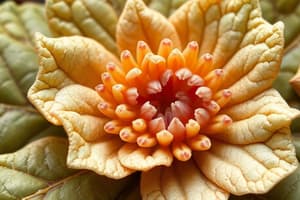Podcast
Questions and Answers
How do plants achieve gaseous exchange without specialized organs?
How do plants achieve gaseous exchange without specialized organs?
- By relying on mechanical support from dead cells.
- Using a network of tracheids in stems.
- Through individual parts taking care of their own needs. (correct)
- Through roots with high gas diffusion rates.
What is one reason plants have lower demands for gas exchange compared to animals?
What is one reason plants have lower demands for gas exchange compared to animals?
- Plants utilize specialized organs located underground.
- Plants have larger respiratory surfaces than animals.
- Plants use stomata exclusively for gas exchange.
- Plants primarily exchange gases during photosynthesis. (correct)
What feature aids in the facilitation of gas exchange in the cells of plants?
What feature aids in the facilitation of gas exchange in the cells of plants?
- Wide stomatal openings allowing rapid gas flow.
- Location of living cells close to the surface. (correct)
- Thick bark layers preventing gas loss.
- Dense packing of parenchyma cells in leaves.
What structural adaptation do stems have that aids in gaseous exchange?
What structural adaptation do stems have that aids in gaseous exchange?
What role does the loose packing of parenchyma cells play in gaseous exchange in plants?
What role does the loose packing of parenchyma cells play in gaseous exchange in plants?
Flashcards are hidden until you start studying
Study Notes
Gas Exchange in Plants
- Plants use stomata and lenticels instead of specialized respiratory organs for gas exchange.
- Each part of the plant manages its own gas exchange, leading to minimal inter-part gas transport.
- Gas exchange demands in plants are lower compared to animals, reducing the need for complex systems.
Photosynthesis and Gas Exchange
- Large volumes of gases are exchanged primarily during photosynthesis.
- Oxygen (O2) is produced internally within photosynthesizing cells, alleviating availability concerns.
- Leaf structure is adapted to support its own gas exchange requirements effectively.
Diffusion and Cellular Organization
- Short diffusion distances for gases exist even in large plants, as living cells are near the surface.
- In stems, living cells are organized in thin layers beneath the bark, enhancing gas exchange efficiency.
- Lenticels create openings on stems to facilitate gas exchange with the environment.
Cellular Structure and Air Spaces
- Dead interior cells offer structural support, while living cells maintain close contact with air.
- The organization of parenchyma cells creates an interconnected network of air spaces in leaves, stems, and roots.
Studying That Suits You
Use AI to generate personalized quizzes and flashcards to suit your learning preferences.




